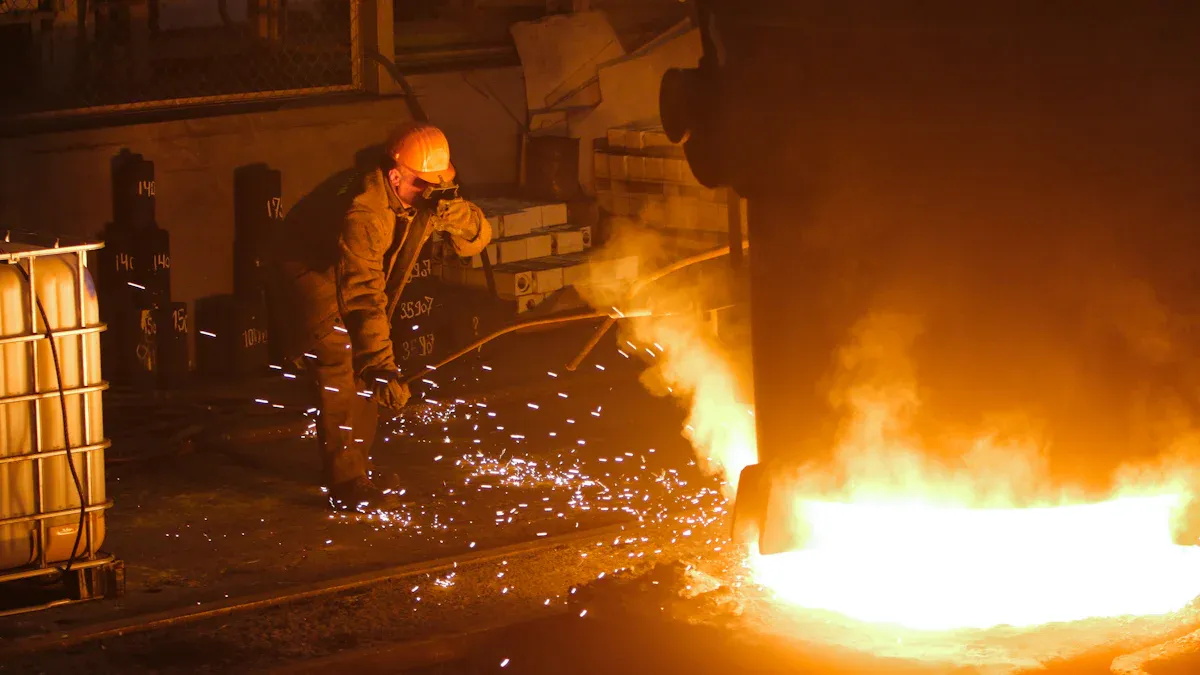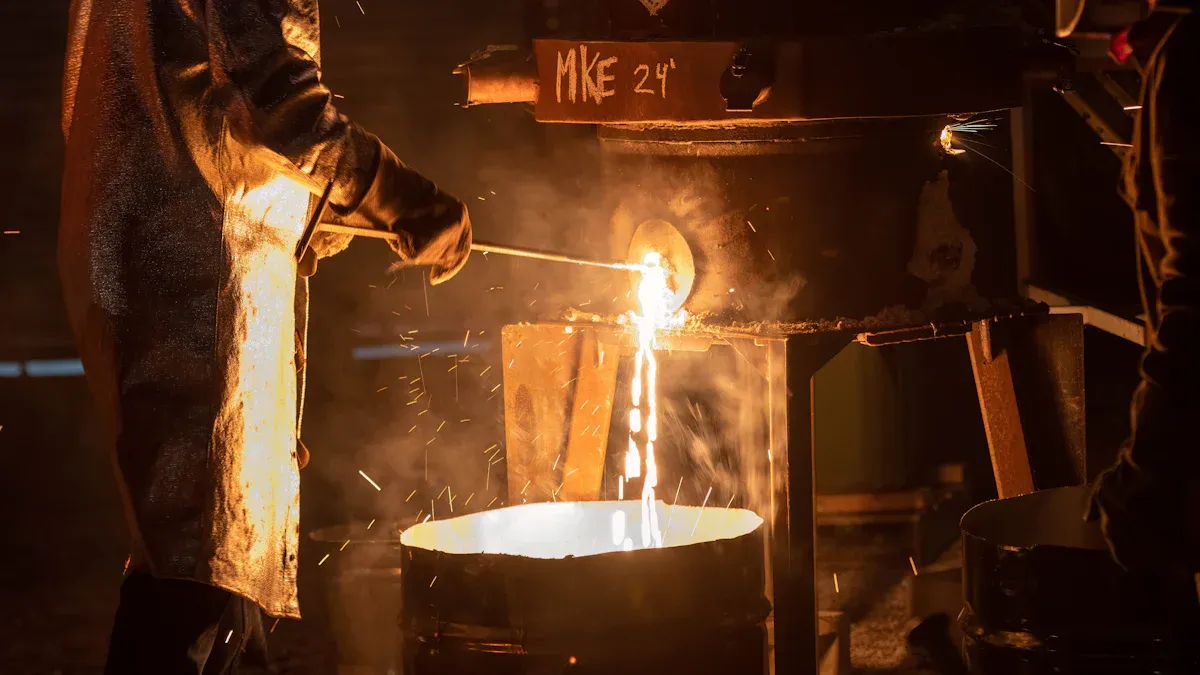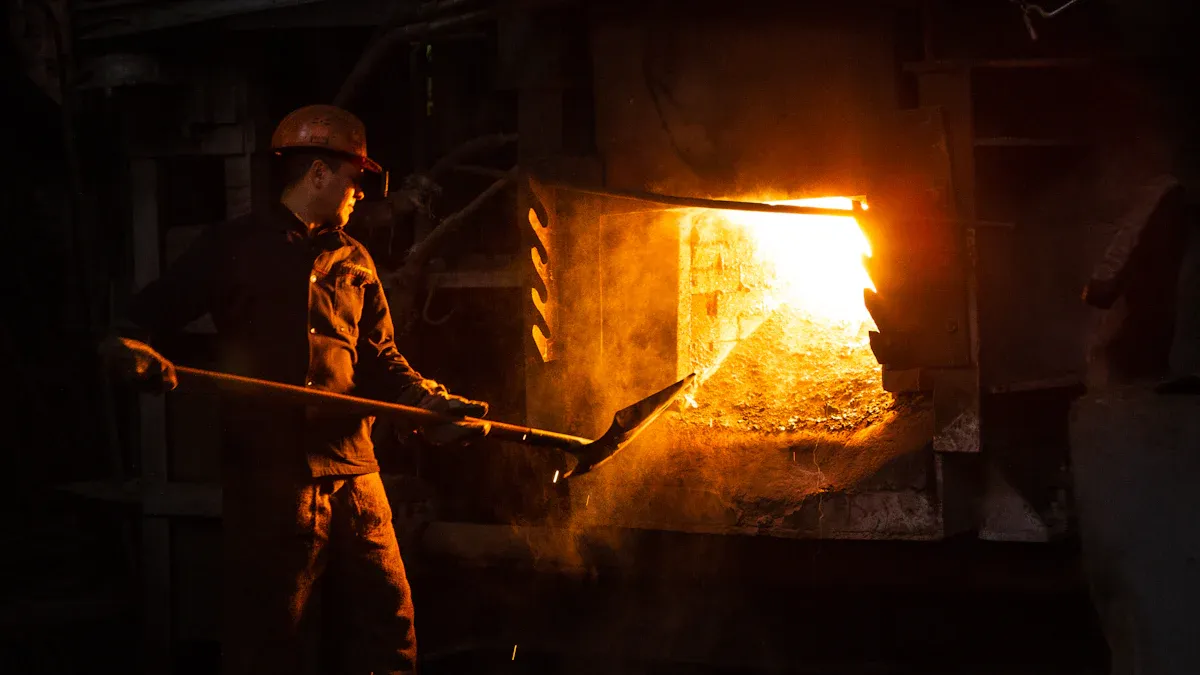What Is Shrinkage Porosity and Why Does It Happen in Metal Casting

Shrinkage porosity is a common problem in metal casting. It happens when hot metal cools and hardens. The metal shrinks and makes empty spaces inside. Shrinkage usually shows up in thick or middle parts of a casting. These spots do not get enough new hot metal. This lack of feeding causes porosity. Shrinkage porosity can cause many problems during production:
Porosity defects might only show up after more work is done, which makes things cost more and slows down finding the problem.
Shrinkage happens in random places, so it is hard to control and can make a lot of scrap metal.
Bad melt quality or wrong heat control can make more porosity, which means more casting problems.
Knowing about shrinkage porosity helps make better castings and saves money by stopping rejections.
Shrinkage Porosity Formation

Metal Solidification Process
When liquid metal goes into the mold, it starts to cool. As it cools, it turns from a liquid into a solid. This is called solidification. The metal forms a group of crystals called dendrites. At first, the metal is still soft and can move. As it gets colder, more of it becomes solid and hard. When about 40% is solid, the outside gets hard. The inside still has some liquid metal left. This is when shrinkage porosity can begin.
The main steps that cause shrinkage porosity are:
The gating system brings hot metal into the mold at first.
Sinks show up on the surface where there is less solid metal.
These sinks get bigger until the outside is hard.
Porosity starts inside where the metal is still liquid and pressure drops.
The inside porosity grows until the whole casting is solid.
The gating system gets hard, and risers feed the casting.
Shrinkage cavities form where solid metal blocks the flow.
Small spaces between crystals change the size and shape of porosity.
How fast the metal cools changes shrinkage porosity. If it cools fast, the outside gets hard quickly. This can trap liquid metal inside. More shrinkage holes and cavities can form. Alloys that stay partly liquid for longer can get more shrinkage porosity. Fast cooling can make fewer pores, but more small pores near the surface.
Volume Contraction and Feeding
When metal turns from liquid to solid, it gets smaller. This is called solid shrinkage. Most casting alloys shrink by about 3% to 8.5% as they get hard. If there is not enough new hot metal, empty spaces form. Liquid shrinkage also happens as the metal cools before it gets hard.
Feeding means sending extra hot metal to fill spaces from shrinkage. If feeding is not enough, shrinkage holes and cavities form inside. Bad gating or riser design, fast cooling, or blocked paths can cause feeding problems. When feeding does not work, empty spaces form inside. These spaces make the casting weak and can cause cracks.
Tip: A good feeding system helps stop shrinkage porosity. It makes sure hot metal gets everywhere during solidification.
Typical Locations in Castings
Shrinkage porosity often shows up in the last places to get hard. These are usually thick or middle parts of the casting. Thick spots cool slowly and stay hot longer. This makes hot spots where shrinkage cavities form. Inside corners and places where metal gathers also cool slowly and have more risk.
A table below shows how different design features change shrinkage porosity risk:
Design Feature | Effect on Shrinkage Porosity Risk |
|---|---|
Thicker Walls | Cool slower, create hot spots, increase risk of shrinkage porosity |
Inside Corners | Slow cooling, increase shrinkage risk |
Abrupt Section Changes | Block feeding, increase shrinkage porosity risk |
Large or Isolated Volumes | Need more feeding, risk shrinkage cavities |
Outside Corners | Cool faster, lower shrinkage risk |
Thinner Walls | Cool faster, lower shrinkage porosity risk |
Porosity is most common in the thermal center of the casting. This is the last part to get hard. Thick sections or sudden changes in thickness block the flow of hot metal. This makes it hard to feed shrinking areas, so shrinkage holes and cavities form. Even wall thickness and smooth changes help lower the risk of shrinkage porosity.
Solidification shrinkage, liquid shrinkage, and solid shrinkage all help make shrinkage defects. Good design and feeding can stop these problems and make better castings.
Causes of Casting Porosity
Casting porosity can happen for many reasons. Problems in design, process, or material choice can cause it. Knowing these reasons helps workers make better castings and fewer mistakes.
Improper Gating and Risers
Bad gating and risers often cause casting porosity. If the gating system does not spread metal evenly, some spots do not fill. Risers that are too small or in the wrong place cannot feed the casting as it cools. This makes empty spaces in thick parts. Engineers use simulation tools to test riser size and spot before making molds. Good design puts risers in the right place and uses smooth gating. This keeps metal moving and lowers porosity.
Note: Most shrinkage defects come from bad gating and riser design.
Uneven Cooling and Solidification
If cooling is not even, the casting gets hot and cold spots. Thick parts cool slower than thin ones. Some areas shrink more than others. If the center cools faster than the outside, stress builds up. These stresses pull the metal apart and make more porosity. Shapes with even walls help metal cool at the same speed. Fast cooling can make the casting stronger, but too fast can trap small holes.
Alloy Composition Effects
Alloy composition changes how metal hardens and feeds. Silicon can help metal flow better and lower shrinkage. Iron and zinc can make more porosity by changing crystal growth. Small changes in alloy mix can change how much porosity forms. Controlling the alloy mix is very important for good castings.
Main Causes of Casting Porosity
Bad gating and riser design
Dirty melt or oxide build-up
Poor mold design
Wrong melting or cooling temperature
Alloy changes
Shrinkage Porosity vs. Gas Porosity
Aspect | Gas Porosity | Shrinkage Porosity |
|---|---|---|
Gases get trapped in the liquid metal | Metal shrinks as it hardens, feeding is not enough | |
Appearance | Round, smooth bubbles | Jagged or long holes |
Location in Casting | Near the top or surface | Below the surface, often in thick or middle parts |
Porosity can come from shrinkage or trapped gas. Gas porosity looks like round bubbles. Shrinkage porosity looks like rough or odd-shaped holes. Good design and control help stop both kinds.
Consequences of Shrinkage Porosity
Structural Weakness
Shrinkage porosity makes weak spots inside metal parts. These empty spaces are places where cracks can start. When you put pressure on the part, cracks may form there. This means the metal is not as strong. It can break more easily and does not last as long. For example, ferritic ductile iron loses a lot of strength from micro-shrinkage porosity. This is even worse when it gets very cold, like below −40°C. More and bigger voids make the metal even weaker. Heat treatment cannot fix these holes. Only strong processes like forging or hot rolling can close some of them, but not all. So, more porosity always means weaker castings.
Surface and Internal Defects
Shrinkage porosity can cause problems on the surface and inside. On the surface, you might see open shrinkage, pipes, or caved areas. Inside, there can be sponge shrinkage, filamentary shrinkage, or dendritic shrinkage. These problems often show up in thick or hot spots, or where thick and thin walls meet. The table below lists some common types:
Defect Type | Location | Description |
|---|---|---|
Open Shrinkage | Surface | A dip that is open to the air. |
Pipes | Surface | Open shrinkage that digs into the casting from the outside. |
Caved Surfaces | Surface | Shallow dips across the outside of the casting. |
Sponge Shrinkage | Internal | Thin, net-like texture found in thick or middle parts. |
Filamentary Shrinkage | Internal | Crack-like lines hidden in thick parts, hard to find. |
Dendritic Shrinkage | Internal | Narrow, random cracks or holes with sharp edges, near hot spots or risers. |
Surface shrinkage can make leaks if the part is cut or drilled. Inside defects may stay hidden but still make the part weaker.
Impact on Corrosion Resistance
Shrinkage porosity also hurts how long a part lasts. Holes and gaps let water and chemicals get inside the metal. This makes rust and corrosion happen faster. The part will not last as long and will need more repairs. If shrinkage reaches the surface, it gives an easy way for bad stuff to get in. Even small inside holes can join together over time and cause the part to fail. Companies lose money from wasted parts and extra work. They can also lose customers and sales. Shrinkage porosity causes problems for safety and costs, not just in the factory but everywhere the part is used.
Preventing Casting Shrinkage

Casting engineers use different ways to stop shrinkage porosity. They try to control how metal cools and fills the mold. Good planning and new tools help make better castings with fewer problems.
Feeding System Design
A good feeding system helps stop shrinkage. Here are some important ideas:
Put risers at hot spots. Risers must stay liquid longer to feed shrinking areas.
Pour the metal at a steady speed. This stops splashing and early freezing.
Make gates and runners fill the mold evenly. Small gates in the right places help stop hot spots.
Keep the gating system at the right heat. This lets liquid metal keep feeding the casting as it cools.
These steps help make the casting design better and stop empty spaces from forming.
Tip: Freezing the metal in one direction and putting risers in the right place are the best ways to stop shrinkage defects.
Process Control and Simulation
Modern foundries use computers to help stop porosity. Simulation software shows how metal moves and cools. It can show where shrinkage porosity might happen. Engineers can change the design before making the mold. This saves time and money.
Benefit | Description |
|---|---|
Accurate Prediction | Finds hot spots and last-to-freeze areas where porosity may form |
Design Optimization | Helps adjust riser and gate placement for better feeding |
Cost Savings | Reduces trial-and-error and scrap rates |
Quality Improvement | Leads to fewer defects and stronger castings |
Simulation tools also help by showing how changes in cooling or feeding change the final casting.
Use of Risers and Chills
Risers and chills work together to control freezing. Risers hold extra liquid metal. They feed the casting as it shrinks. Chills are metal pieces put in the mold. They cool some areas faster and change how the casting freezes.
Put risers at the last places to freeze to feed shrinking areas.
Use chills where risers cannot go. Chills cool thick parts faster.
Use both risers and chills to make the metal freeze toward the risers.
Chills also help make the metal grains smaller and stronger.
These tools help all parts of the casting get enough metal as it freezes. This lowers the chance of shrinkage porosity and makes the casting better.
Shrinkage porosity happens when metal gets smaller as it hardens. Sometimes, the metal cannot fill every space. This leaves empty spots under the surface. These problems often come from quick changes in thickness or slow cooling. Bad feeding design can also cause shrinkage porosity. Finding and stopping shrinkage porosity makes castings stronger and last longer. Foundries should use good gating, risers, and control cooling well. Using these steps helps make better castings and keeps customers happy.
FAQ
What is the main difference between shrinkage porosity and gas porosity?
Shrinkage porosity happens when metal gets smaller as it hardens. This leaves empty spots inside the casting. Gas porosity forms when trapped gases make round bubbles in the metal. Both problems make the metal weaker, but they do not look the same. They also happen for different reasons.
How can engineers detect porosity inside a casting?
Engineers use X-rays, ultrasound, or CT scans to find hidden holes. These tools let them see inside the casting without cutting it open. Looking at the outside only shows problems on the surface.
Why do thicker sections of a casting have more porosity?
Thicker parts cool down slower than thin ones. Slow cooling makes hot spots that are hard to fill. This means more empty spaces form in those thick areas.
Can changing the alloy composition reduce porosity?
Yes. Some elements help the metal flow and fill gaps better. For example, silicon can help lower the chance of porosity. Controlling the alloy mix helps make better castings.
What role do risers play in preventing casting defects?
Risers hold extra hot metal for the casting. They feed the part as it cools and shrinks. Putting risers in the right place helps fill empty spots and lowers defects.
See Also
A Complete Guide To Casting Shrinkage And Machining Allowances
The Effects Of Thermal Stress On Die Casting Parts
Why Thermal Expansion Coefficient Is Crucial In Die Casting
An Easy Explanation Of The Semi-Solid Casting Process
Understanding Die Casting Slides And Their Importance In Production
About Hunan Puka
Established in 2016 and based in Hunan, China, with a liaison point in Berlin, we are a Tier 2 supplier for the automobile industry. We specialize in the production of customized aluminum die-casting parts designed for machines with a closing force ranging from 280 to 1250 tons, with subsequent manufacturing process CNC machining and surface treatment. Our commitment to quality is reflected in our accredited quality management system, certified by ISO9001:2015 and IATF16949:2016 standards.


